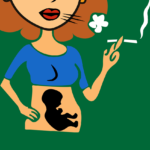
Approximately 8% of woman in the United States smoke when pregnant. Nicotine and carbon monoxide are able to cross the placenta and we know that they can directly (and indirectly) affect foetal neurodevelopment. Because of this, maternal smoking during pregnancy (SDP) is associated with behavioural and neurodevelopmental problems in offspring, and thus may represent a modifiable risk factor for severe mental illness (SMI). Research has demonstrated an increased risk of SMIs including, schizophrenia (and related-symptomology) and bipolar risk in the development of offspring of mothers who smoked during pregnancy.
There is some debate as to the nature and magnitude of causality of SDP on SMI. Some observational studies demonstrate inconsistent effects. Furthermore, studies that take into account parental characteristics such as maternal age and psychiatric history, demonstrate an attenuated influence of SDP. This suggests the effect may be somewhat or wholly driven by (often unmeasured) familial factors.
In a recent study published in JAMA Psychiatry, the authors set out to examine associations between smoking during pregnancy and severe mental illnesses in offspring, in a large population-based cohort from Sweden.

Maternal smoking during pregnancy is associated with behavioural and neurodevelopmental problems in offspring.
Methods
Data was collected from a number of sources including the Swedish Medical Birth Register, Multi-general Register, Crime, Educational and Patient Registers, and cause of death registers from January 1983 to December 2001. Following removal of missing and unavailable data, the authors identified 1,680,219 single births registered during this period.
Importantly, the authors compared the associations to those with discordant cousins or siblings in the same family. These comparisons (particularly the sibling comparisons) enabled stronger tests of causality of smoking. If no association persisted when taking into account siblings in which smoking was discordant, this suggests SDP does not influence the development of SMI.
Moderate smoking during pregnancy was stratified as between 1-9 cigarettes per day, whereas high smoking during pregnancy was >10 cigarettes per day. Maternal and paternal covariates included education levels, criminal convictions and hospitalisations for severe mental illness. Hazard ratios using Cox regression were calculated.
Results
- Offspring exposed to moderate SDP had a greater (25%) rate of being diagnosed with any SMI than offspring with no SDP (HR, 1.25; 95% CI, 1.19 to 1.30)
- Offspring with high exposure to SDP had an even greater rate (51%) of SMI (HR, 1.51; 95% CI, 1.44 to 1.59)
- When adjusting for maternal and paternal covariates these associations were attenuated somewhat, but remained statistically significant
- However, when comparing with discordant siblings these associations were no longer significant, with all confidence intervals including HR = 1.00.
Specific diagnoses
- For bipolar disorder:
- moderate SDP increased the risk by 29% (HR, 1.29; 95% CI 1.22 to 1.36), and
- high SDP increased the risk by 54% (HR, 1.54; 95% CI, 1.45 to 1.63)
- For schizophrenia spectrum disorders:
- moderate SDP increased the risk by 16% (HR, 1.61; 95% CI, 1.08 to 1.24), and
- high SDP increased the risk by 41% (HR, 1.41; 95% CI, 1.31 to 1.52)
- For severe mental illness and substance use disorder:
- moderate SDP increased the risk by 87% (HR, 1.87; 95% CI 1.74 to 2.00), and
- high SDP increased the risk by 133% (HR, 2.33; 95% CI, 2.16 to 2.52)
- Adjusting for maternal and parental covariates again attenuated these associations, but all but one remained statistically significant. Moderate SDP on schizophrenia spectrum disorders was reduced to 3% (HR, 1.03; 95% 0.96 to 1.10)
- For each of the specific diagnoses, when comparing with discordant siblings the risks were substantially attenuated and all associations were no longer significant.

This study failed to find support for a causal effect of smoking during pregnancy on risk of severe mental illness in offspring.
Conclusions
The data from this study demonstrated that smoking during pregnancy (SDP) increased the risk of severe mental illness (SMI). However, when adjusting for maternal and paternal covariates and unmeasured familial confounding these associations were significantly attenuated. This suggests that the link between SDP and the development of SMI can be explained by measured and unmeasured factors shared by siblings.
Limitations
The study is not without limitations:
- First, sibling comparison studies such as this are susceptible to confounding from factors that make siblings different from each other but are not measured. This may lead to over- or underestimations of the effect
- Second, the measure of smoking during pregnancy was taken during a single visit and relied on self report. Furthermore, the measure did not allow fine-grained analyses of smoking behaviours, including timing of smoking and quit attempts
- Finally, the data set was focused on the first 30 years of life in a Swedish cohort, and therefore it is impossible to generalise these results to other populations or severe mental illness diagnosed after the age of 30.
To conclude, this population study adds to the literature to demonstrate that when controlling for unmeasured familial covariates there is no link between smoking during pregnancy and the development of severe mental illness. Furthermore, the population-level association can be explained by measured and unmeasured factors shared by siblings. Importantly, an interesting editorial comment on the paper states that: “with observational data, we can never be certain about causal processes. We can only seek for increased confidence that causal effects are likely present.”

So, smoking during pregnancy may not increase the risk of severe mental illness in the offspring, but it’s still a very bad idea for many other reasons.
Links
Primary paper
Quinn PD, Rickert M, Weibull C, et al (2017). Association between maternal smoking during pregnancy and severe mental illness in offspring. JAMA Psychiatry, 74; 589-596.
Other references
Baguelin-Pinaud A, Robert S, Menard JF, Thibaut F (2010). Prenatal exposure to tobacco and risk for schizophrenia. Comprehensive Psychiatry, 51; 105-110.
Chudal R, Brown AS, Gissler M, Suominem A, Sourander A (2015). Is maternal smoking during pregnancy associated with bipolar disorder in offspring. Journal of Affective Disorders, 171; 132-136
Marangoni C, Hernandez M, Faedda GL (2016). The role of environmental exposures as risk factors for bipolar disorder: a systematic review of longitudinal studies. Journal of Affective Disorders, 193; 165-174.

